Happy marketers, despairing progressives

Classifying (segmenting) Canadians based on their values as consumers and citizens has revealed an even more surprising trend than expected.
In 2022, we have discovered that a type of consumer-loving, social-climbing and extremely conservative Canadian (when it comes to their view of family and gender relationships) has increased their share of the Canadian population from 6% in 2010 to 19% in 2022. A meteoric thirteen-point rise in twelve years!
In 2023, this type is still representing 19% of the Canadian population.
We have named this segment “The Proud” because its members exhibit an acute need for social recognition.
The follwing article is an update of this work with the 2023 data. Note that these new results and their interpretation are entirely consistent to what we found in 2022.
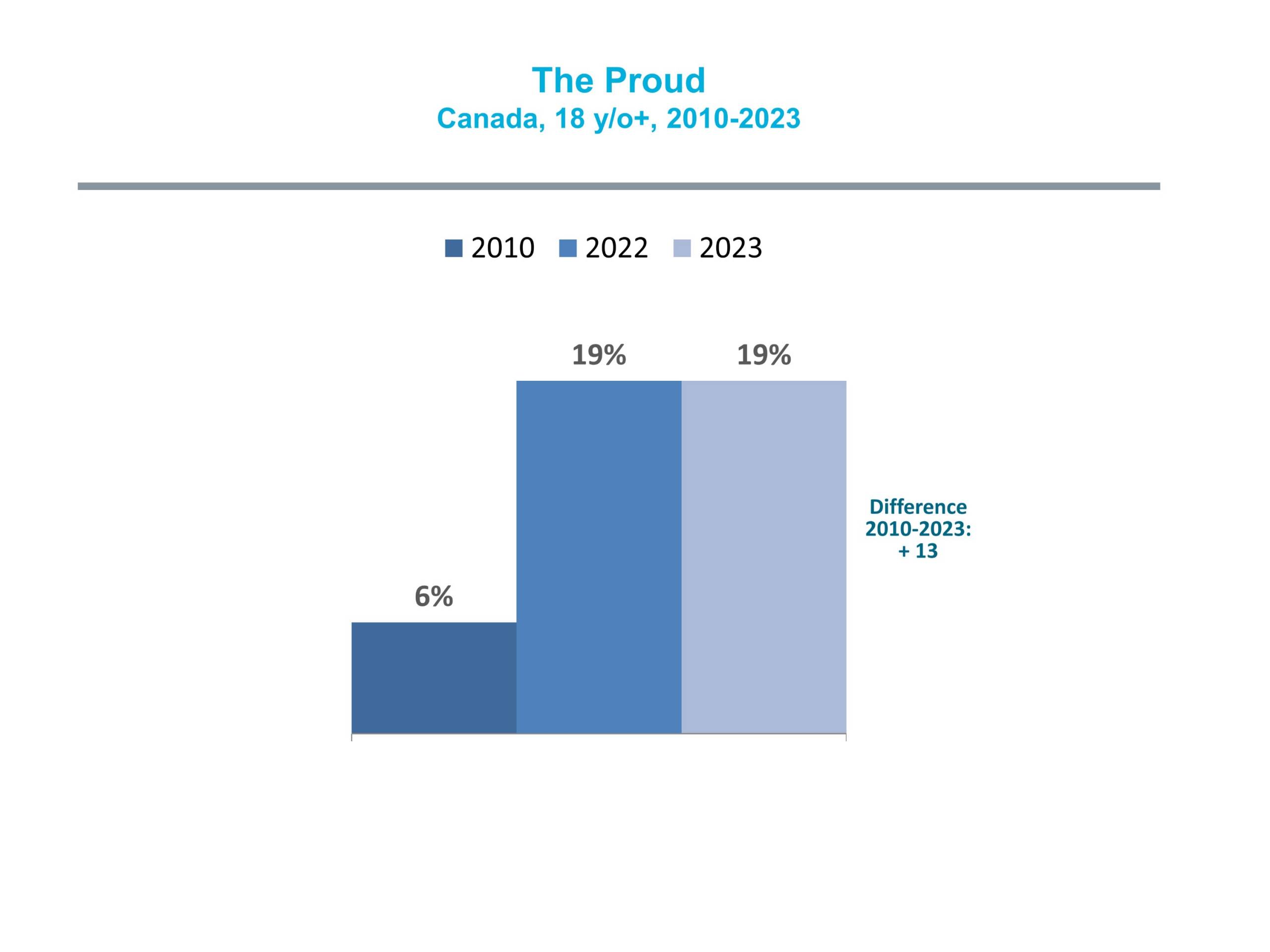
One out of two (52%) are under the age of 35. They live in the country’s large urban agglomerations and have kids at home. A large majority of these individuals (60%) have an ethnic origin other than British or French.
The Proud represent a plurality (37%) of those under 35 years of age in the Canadian population. This new type of youth are keen consumers. They are also embracing the old stereotypical roles of men and women in society.
As we have repeatedly pointed out in our previous articles, consumption has become one of the most important “values” in our society in recent years. As the graph below illustrates, The Proud are, by far, the most loyal and enthusiastic shoppers.
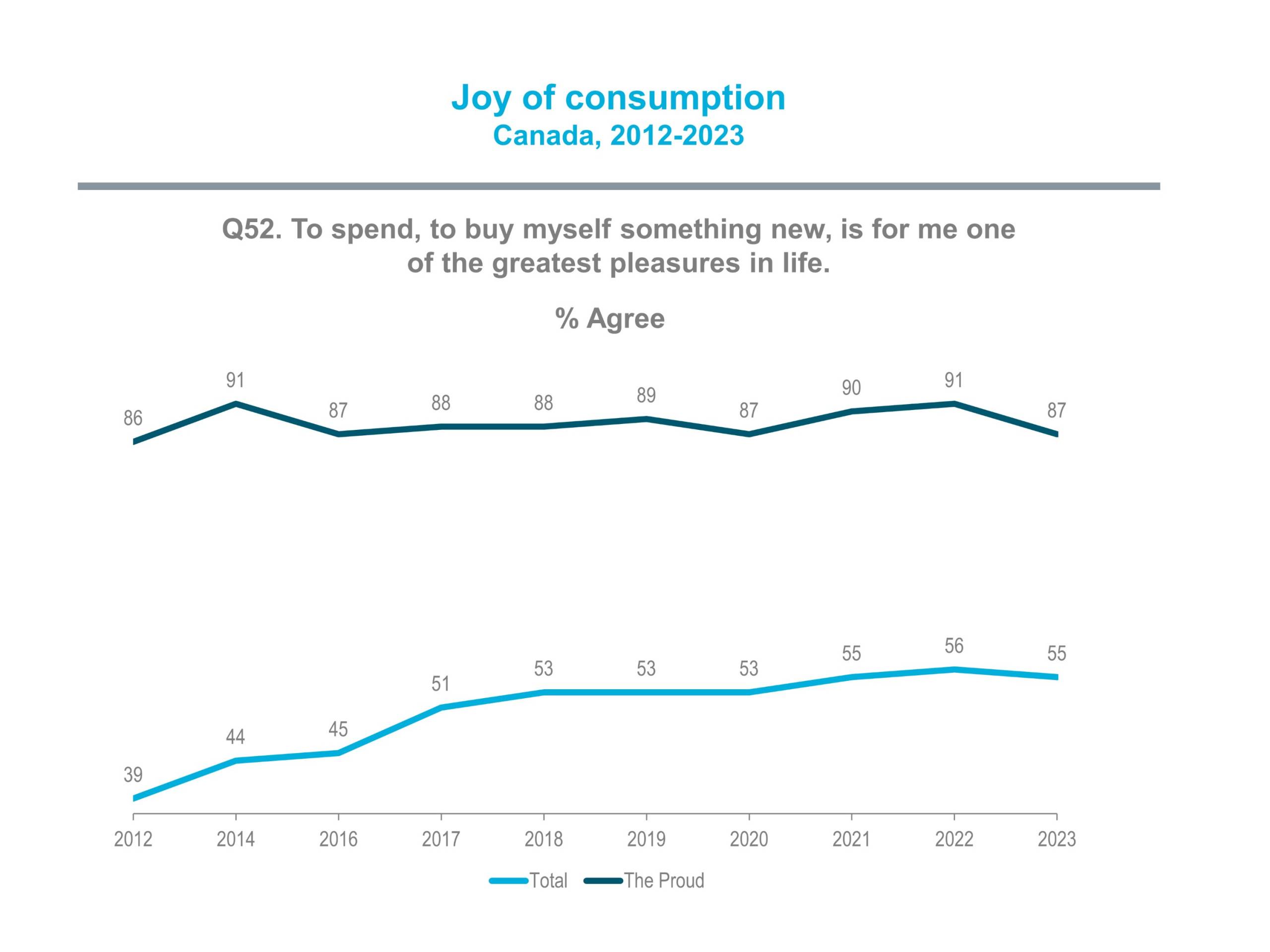
For brands with a significant proportion of this type of consumer among their users/buyers, there is a tremendous opportunity if they address this segment appropriately and with relevant offers and content.
The Proud love beautiful packaging, prefer to shop online, are highly receptive to the added value of available options and are avid followers of social media and streaming content.
At the same time, they are committed to engaging in the most “sustainable” consumption possible, both ethically and ecologically.
A setback for society’s progressive values
While the retail trade and service industries may delight in their great enthusiasm for consumption, they undoubtedly represents a step backwards for society’s progressive aspirations.
Their attachment to traditional stereotypes is striking. Neoconservatism has made strides in Canadian society in recent years, but this segment represents one of the most flamboyant expressions of it.
The two graphs below illustrate the rise of neoconservative values in Canadian society and the position of The Proud on certain issues.
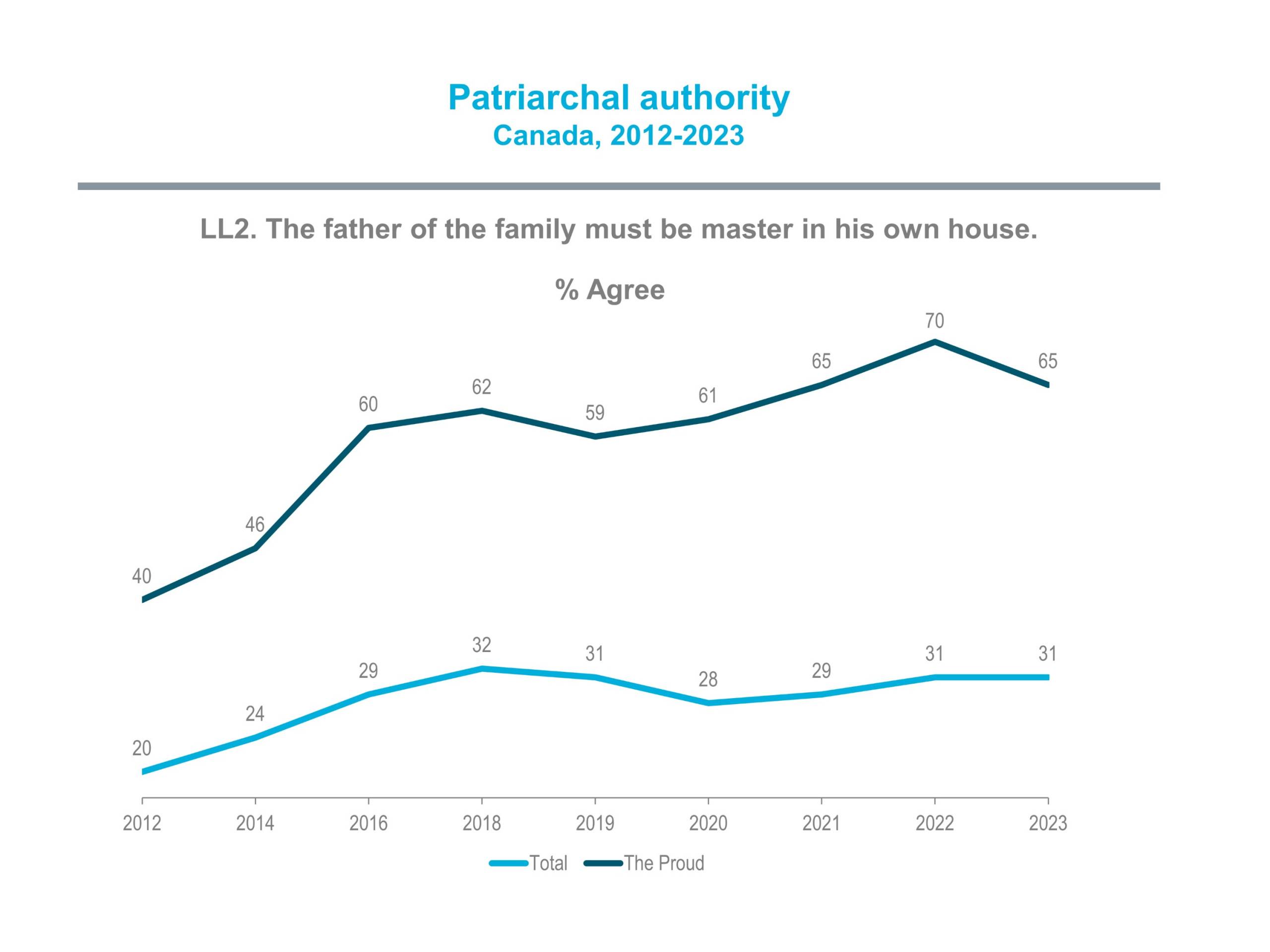
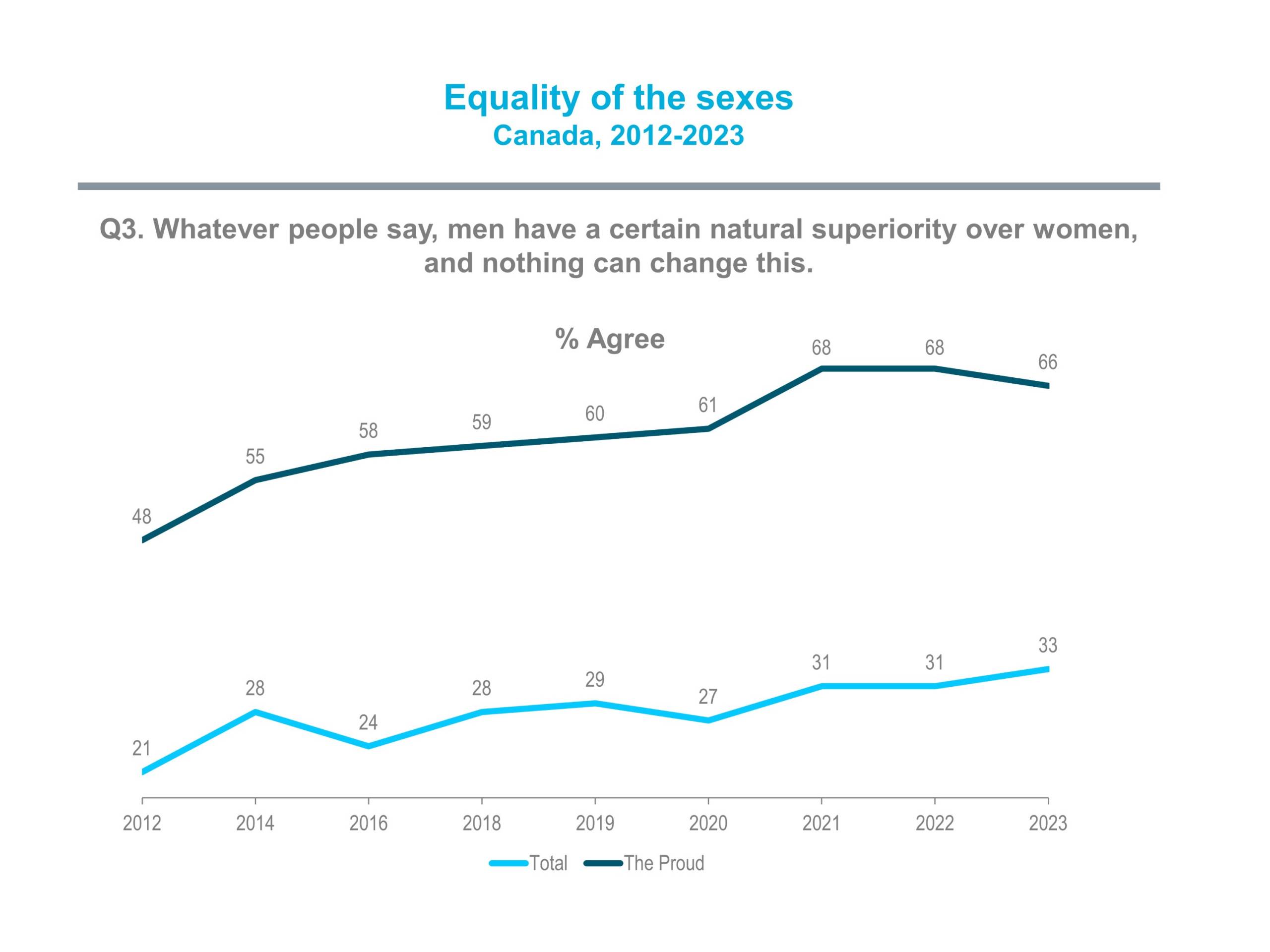
Two trends account for this phenomenon. The fact that we find a large proportion of ethnic community members (regardless of generation) in this segment partly explains these results. Many of these communities hail from much more traditional cultures than ours.
But this factor does not account for everything. Not all members of ethnic communities in Canada display such levels of conservatism.
The other and perhaps more important factor is the deep sense of disempowerment The Proud feel in their lives, regardless of ethnicity (whence The Proud’s keen need for personal recognition). They feel slightly disconnected because of societal changes yet refuse to be marginalized.
An article published on our website in June 2022 deals specifically with the rise of this disempowerment among Canadians and the neoconservatism it has engendered.
This trend is still climbing in 2023.
This type of mentality tends to provoke a strong desire for escape and the potential gratification through consumption becomes a sought-after outlet; hence, the concomitant growth of these indicators.
However, despite this feeling of disempowerment, the Proud feel they can adapt to current uncertainties and display a very strong desire for social affirmation.
The different types of Canadian consumers
We have focused on The Proud because it is the segment that has experienced the most growth, as well as being the most surprising. As an expression of the neoconservatism that is becoming strongly rooted in our social fabric, this segment represents the most astonishing social phenomenon we have witnessed in recent years.
But it is also important to examine the other types of consumers/citizens.
Six segments comprise the panorama of the different types of Canadians:
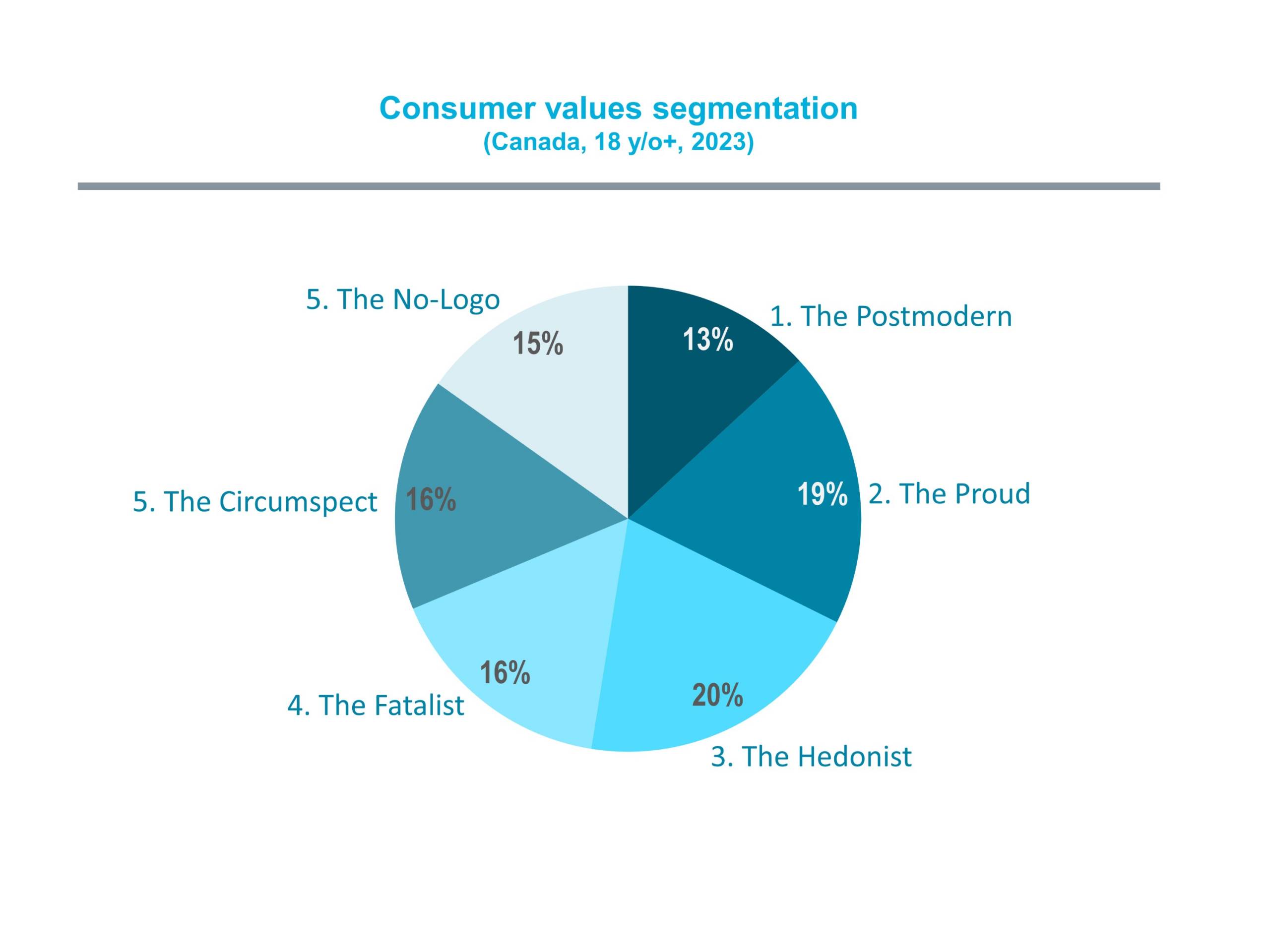
The Postmodern (13%)
Driven by a deep desire to fulfill their personal potential and be in total control of all the levers of their lives and destiny, the members of The Postmodern segment are highly motivated by their need for fulfillment and the need to express their uniqueness and creativity. They are ardent proponents of gender equality and extremely receptive and open to all forms of diversity (social, ethnic, gender, etc.). They are also highly engaged with the ecological and ethical issues of the day.
They are enthusiastic consumers, early adopters and delighted by innovation, yet attempt to shop in a sustainable and responsible way. Although they are very hedonistic and keen in their desire to enjoy all of life’s pleasures, they opt for a very healthy lifestyle. All this makes them quite eclectic.
They like to buy personal care products and prefer to shop in-store, even though they prefer to work remotely from home instead of at the office. They follow social media, although they read more content than they post, and are big fans of streaming content.
This type of Canadian comprises an over-representation of women, young people under the age of 35 and people with higher-than-average incomes.
In quantitative terms, this segment has remained relatively stable, dropping by 4 points, from 17% to 13% of the Canadian population, from 2010 to 2023.
The Hedonist (20%)
The members of The Hedonist segment take pleasure in whatever forms of gratification are available to them, especially the joys of consumption. For The Hedonist, too, society is changing too fast. They are very conservative (regarding gender equality, diversity, etc.) in reaction to the difficulty they experience dealing with the uncertainties of life today.
Their priority in life is a carefree pursuit of pleasure. They are completely disengaged from all social and ecological causes.
In many ways, The Hedonist is very similar to The Proud in their consumption, conservatism and need for recognition.
However, in contrast to The Proud, members of The Hedonist segment have great difficulty adapting to today's uncertainties. They are quite passive, benefitting from life’s pleasures in an apathetic way, without any need to assert themselves socially.
They consume a great deal of social media and streaming content and are consumers of “adult entertainment”!
Their numbers have also declined sharply, from 28% of the population in 2010 to 17% in 2022, with a small uptick in 2023 to 20%.
Their sociocultural proximity to The Proud suggests that many of them may have migrated to this latter segment over the years.
This segment comprises an over-representation of people under the age of 45, manual labourers, technicians, people with average incomes and households with children.
The Fatalist (16%)
This is another very conservative segment with an especially poor sense of control over their lives, whence their high level of fatalism. They are convinced that they are powerless against “fate”!
They feel that society is not only changing too fast but has also become toxic and anxiety-provoking. Uncertainty, risk, the social jungle are all manifestations of a world that The Fatalist believe society is going to hell and in a handbasket, a world to which they are having trouble adapting.
Their conservatism is nostalgic: everything was better and less complicated in the past. This accounts for their dislike of all forms of diversity (social, ethnic, gender, etc.) in modern society
It is striking that they read no newspapers and are quite uninformed about current events. They seek escape through gaming and televised sports, as well as streaming music (Spotify, YouTube, etc.).
This segment has been totally stable over the years: 17% of the Canadian population in 2010, 16% in 2023.
In this segment, there is an over-representation of men, people 55 and older, lower incomes and Quebecers.
The Circumspect (16%)
The Circumspect have much in common with The Fatalist with respect to their apocalyptic view of society and the uncertainty prevailing there.
But this defeatist and threatening view of society does not result in conservative values. The Circumspect are proponents of female equality and emancipation. They still feel in control of their lives and are able to manage despite their Darwinian view of modern society.
But their primary characteristic is their circumspection, their cautiousness, in the way they consume and in other areas of their lives.
They systematically avoid risk. Their purchasing criteria are essentially price oriented. They are frugal consumers who practice a kind of introverted forced simplicity. They shop mainly in discount stores (and in-store).
They consume very little social media, opting for traditional media and live content at scheduled broadcast times.
This segment has grown by 9 points in recent years, from 7% of the Canadian population in 2010 to 16% in 2023, as more people encounter difficulties dealing with the uncertainties of today's world.
This segment comprises an over-representation of people 55 years of age and up, low incomes and people living in localities outside the major urban centres.
The No-Logo (15%)
The reference to Naomi Klein's book, No Logo: Taking Aim at the Brand Bullies (Knopf Canada, Picador, December 1999), is intentional. The members of The No-Logo segment are committed “greens” who believe that the consumer society is creating superfluous needs that we must resist for ethical and ecological reasons. Their frugality can go as far as voluntary simplicity.
Their personal values are quite similar to those of The Postmodern, except for their frugal consumption. They feel empowered, have a strong desire for personal fulfillment, believe deeply in gender equality and enthusiastically embrace all forms of social diversity.
They have a very pessimistic view of the planet’s future and are very aware of the uncertainties in life today.
They are proponents of the circular economy. They repair. For them, buying new is a last resort. They garden and enjoy preparing food from scratch. They walk and take public transit. They make very little use of the Internet, social media, streaming or in-store shopping.
They mainly consume traditional media and still read printed newspapers.
This segment has declined by 10 points in recent years, from 25% of the Canadian population in 2010 to 18% in 2022, and to 15% in 2023.
Some of them may have migrated to The Circumspect segment because of their difficulty dealing with today’s uncertainties.
The No-Logo has an over-represented of women, people aged 55 and over, people with university degrees and residents of small municipalities.
How the types of Canadians have evolved
The following table summarizes how each of the segments has evolved in recent years.
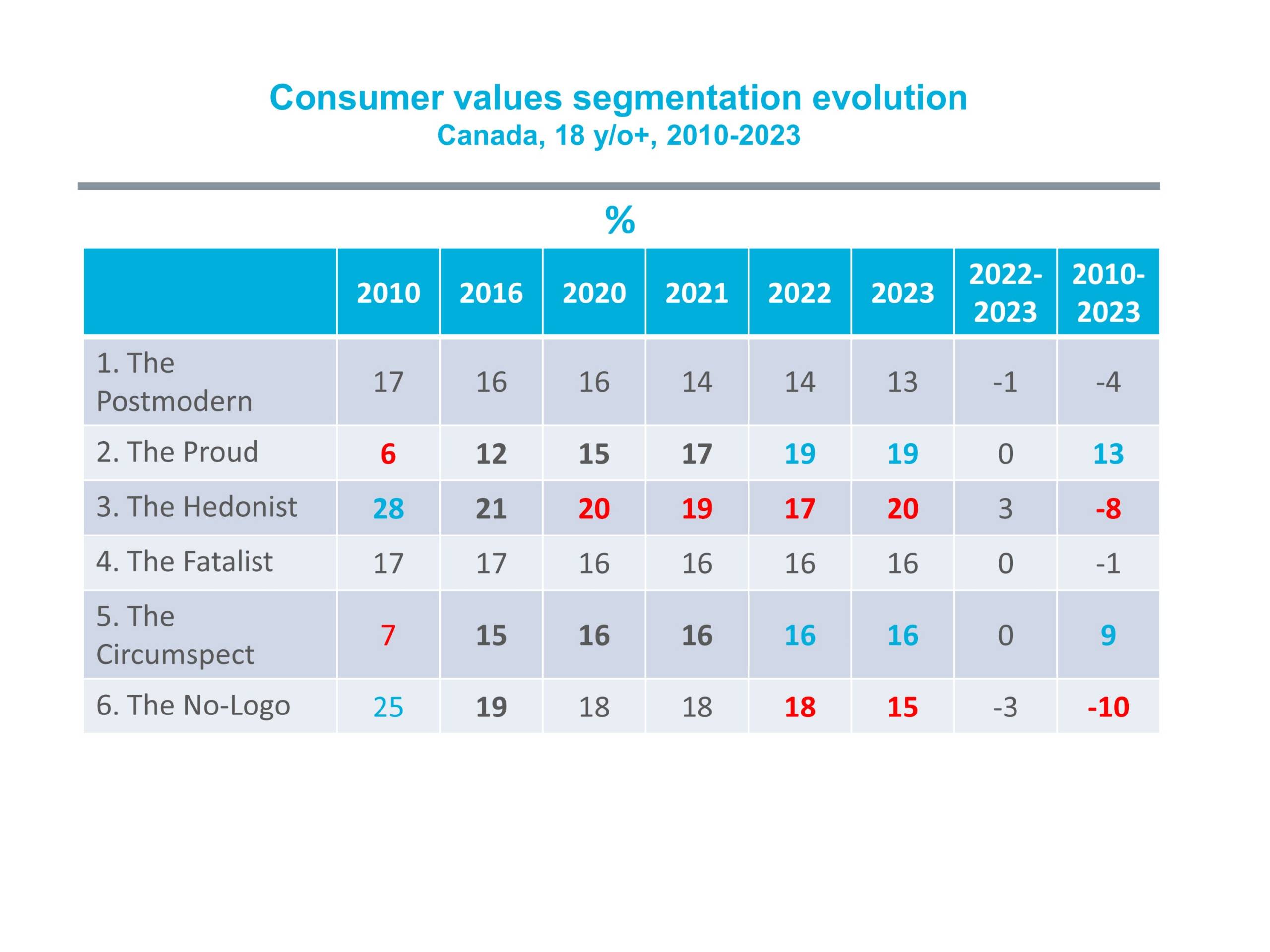
An overview of the disparity among Canadian consumers and citizens
A practical way to provide an overview of this classification of Canadians is to project the segments onto our sociocultural map.
This map shows the values that we monitor on the two axes that divide Canadians based on the synthesis of their values.
As citizens and as consumers, our map contrasts people with the following mental postures:

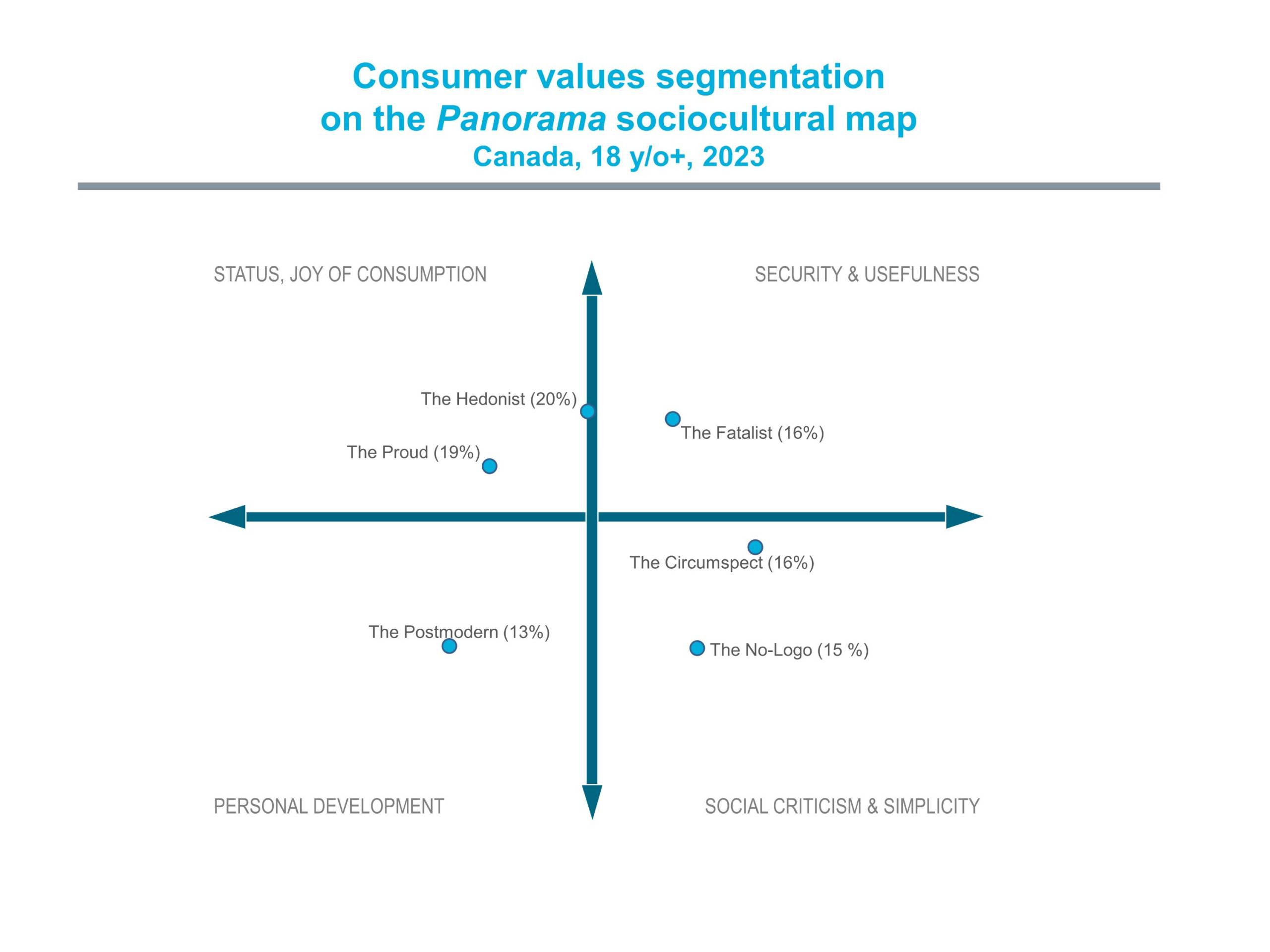
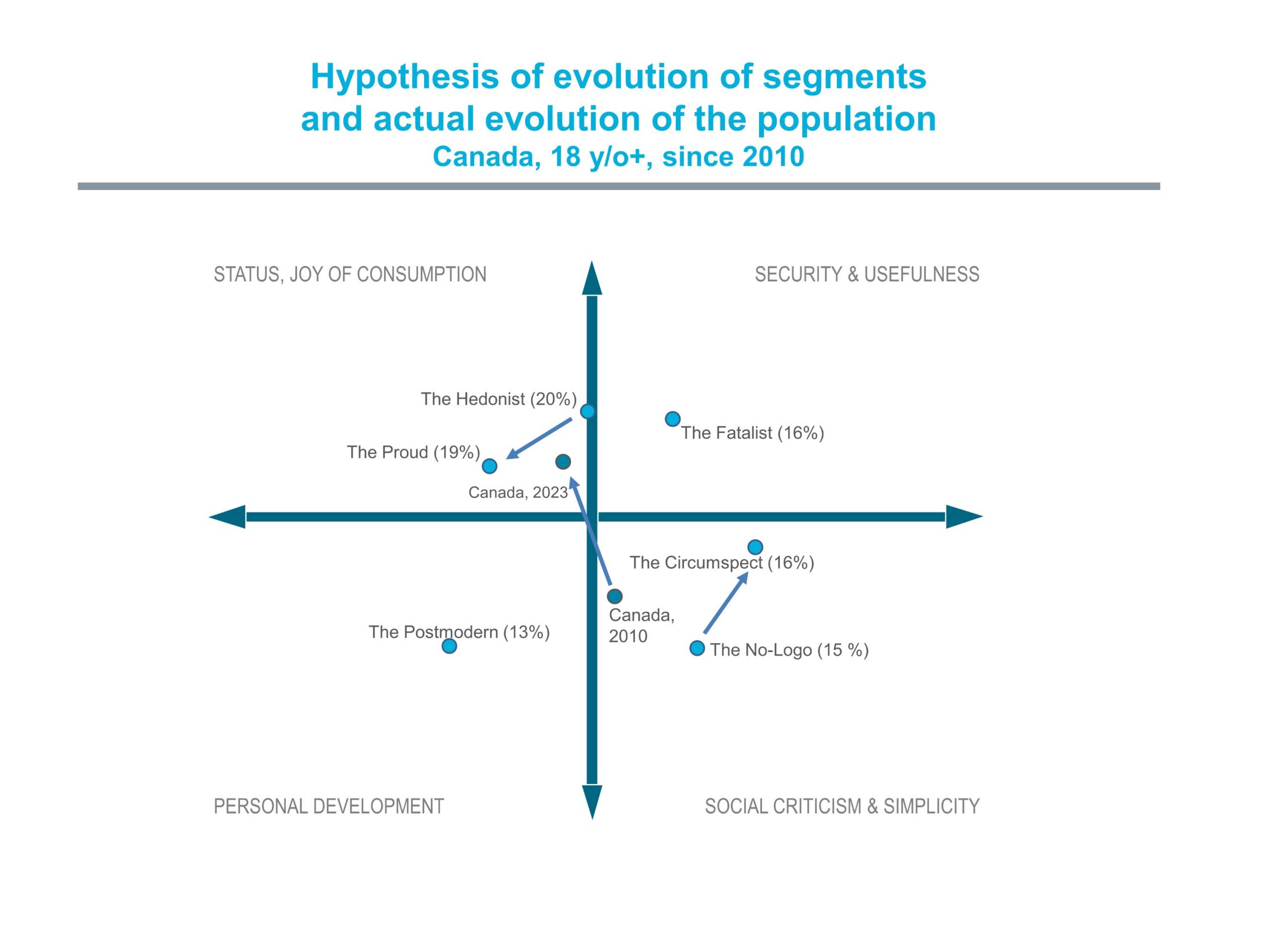
Business opportunities and potential neoconservative excesses
We must always be cautious when projecting that current trends will continue to move in the same direction in the future. Admittedly, in this case the temptation is strong.
After all, do we really believe that our world will become less complex in the coming years and that the global forces impacting our lives will stop making us feel less empowered?
It is hard to believe that this will be the case so it is easy to envision a scenario in which neoconservative tendencies will continue to intensify. Neoconservatives are getting better organized politically, as are their various networks.
Consumption as an outlet should continue to retain its appeal and may even rise under the impetus of the new, young, keen (and conservative) consumers. We can expect a healthy consumer marketplace if, of course, we succeed in curbing inflation.
On the other hand, Canada is one of the most progressive countries in the world. We can also envision a scenario of adaptation to life’s uncertainties through our wealth-distribution policies.
However, it will still be necessary to educate this new conservative generation about the country's heritage of equality and humanism